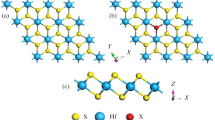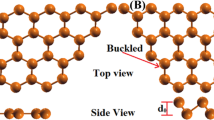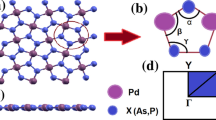Abstract
In this paper, the effects of doping VIA group non-metallic elements (O, Se, Te) on the optoelectronic properties of monolayer 1T-ZrS2 were calculated using a first-principles approach. The results showed that the doped atoms could successfully modulate the band gap of monolayer 1T-ZrS2. By applying biaxial tensile strain in the x–y direction, it is found that the band gap of the pristine monolayer 1T-ZrS2 increases first and then decreases, reaching the maximum at 6%. On this basis, a further 6% tensile strain was applied to the three doped systems. It was found that after applying strain, the band gap of all doped systems increased, and the indirect band gap changed to a direct band gap, improving the luminescence efficiency of the materials. The analysis of the optical properties revealed that all systems have a high reflectance of photons in the near ultraviolet region, which had a considerable impact on the transmittance. The study’s findings offer a theoretical guide for using monolayer 1T-ZrS2 in microelectronic devices.








Similar content being viewed by others
REFERENCES
F. Schwierz, Nat. Nanotechnol. 5, 487 (2010).
L. Wei, G. L. Liu, D. Z. Fan, et al., Phys. B (Amsterdam, Neth.) 545, 99 (2018).
J. N. Coleman, M. Lotya, et al., Science (Washington, DC, U. S.) 331, 568 (2011).
Z. Zeng, Z. Yin, X. Huang, et al., Angew. Chem. 123, 11289 (2011).
M. Zhang, Y. Zhu, X. Wang, et al., J. Am. Chem. Soc. 137, 7051 (2015).
L. Li, H. Wang, X. Fang, et al., Energy Environ. Sci. 4, 2586 (2011).
Y. L. Zhang, X. C. Wu, Y. R. Tao, et al., Chem. Commun., No. 23, 2683 (2008).
L. Li, X. Fang, T. Zhai, et al., Adv. Mater. 22, 4151 (2010).
X. Zhao, X. Zhang, T. Wang, et al., J. Alloys Compd. 748, 798 (2018).
H. Xiang, B. Xu, W. Zhao, et al., RSC Adv. 9, 13561 (2019).
Q. Xin, X. Zhao, X. Ma, et al., Phys. E (Amsterdam, Neth.) 93, 87 (2017).
H. Y. Lv, W. J. Lu, D. F. Shao, et al., J. Mater. Chem. C 4, 4538 (2016).
M. D. Segall, P. J. D. Lindan, M. J. Probert, et al., J. Phys.: Condens. Matter 14, 2717 (2002).
J. P. Perdew, Phys. Rev. B 33, 8822 (1986).
X. Xue, X. Wang, Y. Song, et al., J. Alloys Compd. 739, 723 (2018).
Y. Li, J. Kang, and J. Li, RSC Adv. 4, 7396 (2014).
H. Zhang, Y. Zhang, H. X. Chen, et al., Thin Solid Films 735, 138875 (2021).
J. Bao, L. Yang, and S. Chen, Russ. J. Phys. Chem. A 96, 2900 (2022).
J. Singh, B. Singh, G. Singh, et al., AIP Conf. Proc. 1942, 090020 (2018).
M. Zemzemi, N. Elghoul, K. Khirouni, et al., J. Exp. Theor. Phys. 118, 235 (2014).
D. Wang, L. Yang, and J. Cao, Mod. Phys. Lett. B 35, 2141002 (2021).
N. Wu, X. Zhao, X. Ma, et al., Phys. E (Amsterdam, Neth.) 93, 1 (2017).
S. Chen, L. Yang, and D. Wang, Russ. J. Phys. Chem. A 96, 3031 (2022).
T. V. Vu, A. A. Lavrentyev, D. V. Thuan, et al., Superlatt. Microstruct. 125, 205 (2019).
G. Tse and D. Yu, Comput. Condens. Matter 4, 59 (2015).
K. Wang, Q. Xiao, Q. Xie, et al., J. Electron. Mater. 48, 5135 (2019).
A. A. Mubarak, Int. J. Mod. Phys. B 30, 1650141 (2016).
Q. Zhao, Y. Guo, K. Si, et al., Phys. Status Solidi B 254, 1700033 (2017).
D. Wang, L. Yang, and J. Cao, Chem. Phys. 546, 111181 (2021).
Funding
The work was supported by National Natural Science Foundation of China (Approval no. 11102118); Liaoning Province “Millions of Talents Project” Fund (Approval no. 100010131).
Author information
Authors and Affiliations
Corresponding author
Ethics declarations
The authors declare that they have no conflicts of interest.
Rights and permissions
About this article
Cite this article
Wei, X., Yang, L. & Bao, J. Effect of Non-Metallic Doping and Tensile Strain on Photoelectric Properties of 1T-ZrS2 Monolayer. Russ. J. Phys. Chem. 97, 2501–2509 (2023). https://doi.org/10.1134/S0036024423110353
Received:
Revised:
Accepted:
Published:
Issue Date:
DOI: https://doi.org/10.1134/S0036024423110353




